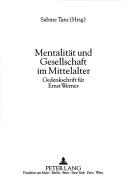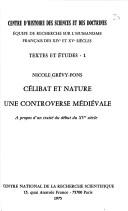| Listing 1 - 10 of 31 | << page >> |
Sort by
|
Book
ISBN: 2711616800 9782711616800 Year: 2004 Volume: *233 Publisher: Paris: Vrin,
Abstract | Keywords | Export | Availability | Bookmark
 Loading...
Loading...Choose an application
- Reference Manager
- EndNote
- RefWorks (Direct export to RefWorks)
Book
ISBN: 3486557009 3486701630 Year: 2004 Volume: 68 Publisher: München Oldenbourg
Abstract | Keywords | Export | Availability | Bookmark
 Loading...
Loading...Choose an application
- Reference Manager
- EndNote
- RefWorks (Direct export to RefWorks)
Bereits in zweiter Auflage entfaltet diese Einführung die Welt der mittelalterlichen Frömmigkeit: Der Vormoderne war die Religion selbstverständlich. Je nach Kulturstand hatte sie verschiedene Formen und Gestaltungen. Kennzeichnend für die mittelalterliche Frömmigkeit ist, dass die Buchreligion Christentum in eine orale Gesellschaft vordrang und diese umgestaltete: Schreiben und Lesen, Philosophie und Theologie entwickelten sich. Die Religionspraxis bildete dabei vielerlei Spielarten aus: Reliquien-Verehrung, Blutkulte, Stiftungswesen, Ablass, Passionsfrömmigkeit - insgesamt ein Gemisch, das nicht immer als genuin christlich gelten kann. Eben in dieser Vermengung von vielerlei Elementen liegt die Spannung; zum Ende des Mittelalters erwächst eine geradezu explosive Mischung. Dies ansichtig zu machen gelingt - entgegen der Vorgehensweise der älteren Forschung, die allzu oft konfessionell und national urteilt - erst aus einer religions- und sozialgeschichtlichen Perspektive, der sich Arnold Angenendt vorzugsweise widmet.
Christian church history --- anno 500-1499 --- Europe --- Church history -- Middle Ages, 600-1500. --- Religion. --- Religious thought -- Middle Ages, 600-1500. --- Regions & Countries - Europe --- History & Archaeology --- Germany
Book
ISSN: 00797812 ISBN: 9782600059213 2600059210 Year: 2019 Volume: 269 Publisher: Genève : Droz,
Abstract | Keywords | Export | Availability | Bookmark
 Loading...
Loading...Choose an application
- Reference Manager
- EndNote
- RefWorks (Direct export to RefWorks)
Parmi les sept péchés capitaux au Moyen Âge, l’acédie est considérée traditionnellement comme l’ancêtre de la paresse, de la mélancolie ou de la dépression. Elle se signale par un manque de ferveur qui plonge le religieux dans un état spirituel de tristesse et de torpeur. La théologie morale du Moyen Âge a dressé un tableau clinique de l’acédie, sans toujours détailler les moyens concrets de lutter contre cette pathologie spirituelle. Le texte édité et présenté ici – l’Inflammatorium pœnitentiæ – constitue à cet égard une notable exception. Cet exercice spirituel enrôle l’imagination pour concevoir un monde parfait, rutilant et plaisant propre à enflammer un désir vacillant de paradis. Florent Coste situe cet usage spirituel de la fiction au sein de traditions théologiques et littéraires qui le rendent plus intelligibles : l’hédonisme des paradis coraniques, la psychologie cistercienne de l’imagination, l’ascèse franciscaine de la méditation.
Acédie --- Théologie morale --- Ascèse --- Moyen âge. --- Acedia --- Apathy --- Religious thought --- Religious aspects --- Christianity --- Apathy - Religious aspects - Christianity --- Religious thought - Middle Ages, 600-1500
Book
ISBN: 9780754667063 9781472409294 0754667065 1472409299 Year: 2013 Volume: *33 Publisher: Farnham Ashgate
Abstract | Keywords | Export | Availability | Bookmark
 Loading...
Loading...Choose an application
- Reference Manager
- EndNote
- RefWorks (Direct export to RefWorks)
Joachim of Fiore --- Religious thought --- Joachim, --- Influence --- Église --- Joachim de Flore, --- Religious thought - Middle Ages, 600-1500 --- Joachim, - of Fiore, - ca. 1132-1202 --- Joachim, - of Fiore, - approximately 1132-1202 - Influence --- Joachim, - of Fiore, - approximately 1132-1202

ISBN: 3631455453 9783631455456 Year: 1993 Volume: 2 Publisher: Frankfurt am Main : P. Lang,
Abstract | Keywords | Export | Availability | Bookmark
 Loading...
Loading...Choose an application
- Reference Manager
- EndNote
- RefWorks (Direct export to RefWorks)
Middle Ages --- Civilization, Medieval --- Religious thought --- Moyen Age --- Civilisation médiévale --- Congresses --- Congrès --- Werner, Ernst, --- Congresses. --- Civilisation médiévale --- Congrès --- Middle Ages - Congresses --- Civilization, Medieval - Congresses --- Religious thought - Middle Ages, 600-1500 - Congresses.
Book
ISBN: 2862720984 9782862720982 Year: 1996 Publisher: Saint-Etienne, Loire : Publications de l'Université de Saint-Etienne,
Abstract | Keywords | Export | Availability | Bookmark
 Loading...
Loading...Choose an application
- Reference Manager
- EndNote
- RefWorks (Direct export to RefWorks)
Religious thought --- Reformation --- Pensée religieuse --- Réforme (Christianisme) --- Bible --- Criticism, interpretation, etc. --- History --- Europe --- Church history --- Histoire religieuse --- Pensée religieuse --- Réforme (Christianisme) --- Religious thought - Middle Ages, 600-1500. --- Church history - Middle Ages, 600-1500. --- History.
Book
ISBN: 9782503530314 9782503540108 2503540104 2503530311 Year: 2013 Volume: 25 Publisher: Turnhout Brepols
Abstract | Keywords | Export | Availability | Bookmark
 Loading...
Loading...Choose an application
- Reference Manager
- EndNote
- RefWorks (Direct export to RefWorks)
Empathy is a deep feeling or intuition for kinship transcending self-preoccupied individuality. This book is about empathy in the Middle Ages, before it had a name.The authors begin by tracing the origins of empathy in pre-Christian Antiquity and early Christianity, especially in mysteries of divine justice, by which the good often suffered and the wicked prospered and, as with surgical healing, compassion was manifested by inflicting pain. The authors also explore many facets of empathy’s development in the Latin West, criss-crossing the artificial borders of academic departments to reveal interlocking connections that give emotional power to images, whether verbal, pictorial, or performative. In a powerful multi-disciplinary collaboration, they identify conditions and limits of empathy, and areas in which the dynamic between insiders and outsiders forced subversive explorations of what it meant to be human. The doctrine of Christ as mediator of divine love dominated medieval thought about empathy as a human instinct. Taken together, like magnetic poles, two pictures in this book represent that mediation in action. The cover illustration, a mid-ninth-century ivory plaque from Carolingian Gaul, depicts Christ, the Divine Word, Love incarnate, glorified, enthroned, and adored by angels as creator, judge, and teacher. The second, Plate 1, from the same period and region, represents the act that sealed the mediation of divine love to humanity: Christ the man, tortured and dying for love.
History of civilization --- Philosophy and psychology of culture --- Christian spirituality --- anno 500-1499 --- Empathy --- Religious thought --- Empathie --- Pensée religieuse --- Religious aspects --- Christianity --- Sources --- Christianity. --- Sources. --- Pensée religieuse --- Middle Ages, 600-1500 --- Middle Ages, 500-1500 --- Empathy - Religious aspects - Christianity --- Empathy - Religious aspects - Christianity - Sources --- Religious thought - Middle Ages, 600-1500 --- Moyen Age

ISBN: 222201848X 9782222018483 Year: 1975 Volume: 1 Publisher: Paris C.N.R.S.
Abstract | Keywords | Export | Availability | Bookmark
 Loading...
Loading...Choose an application
- Reference Manager
- EndNote
- RefWorks (Direct export to RefWorks)
Celibacy --- Religious thought --- Christianity --- 254*5 --- -Religious thought --- -#GROL:SEMI-254*5 --- Religion --- Clerical celibacy --- Clergy --- Sexual abstinence --- Priesterlijk celibaat --- Religious aspects --- Christianity. --- 254*5 Priesterlijk celibaat --- #GROL:SEMI-254*5 --- Church history --- Theology, Doctrinal --- Church discipline --- Monastic and religious life --- Monastic and religious life of women --- History --- Celibacy - Christianity --- Religious thought - Middle Ages, 600-1500
Book
ISBN: 0860782549 9780860782544 Year: 1989 Volume: 306 Publisher: Northampton Variorum Reprints
Abstract | Keywords | Export | Availability | Bookmark
 Loading...
Loading...Choose an application
- Reference Manager
- EndNote
- RefWorks (Direct export to RefWorks)
Christian spirituality --- Christian theology --- Bonaventure --- Religious thought --- Philosophy, Medieval. --- Philosophy, Medieval --- -Medieval philosophy --- Scholasticism --- Religion --- Bonaventure Saint, Cardinal --- -Bonaventure Saint, Cardinal --- Medieval philosophy --- Church history --- Theology, Doctrinal --- History --- Bonaventure, --- Boaventura, --- Bonaventura, --- Bonawentura, --- Boneventura, --- Buenaventura, --- Būnāwintūrā, --- Fidanza, Giovanni, --- Sheng Wen-te, --- Wen-te, --- Pseudo-Bonaventure --- Addresses, essays, lectures --- Religious thought - Middle Ages, 600-1500.

ISBN: 0833712802 9780833712806 Year: 1974 Volume: 151 Publisher: New York (N.Y.): Franklin
Abstract | Keywords | Export | Availability | Bookmark
 Loading...
Loading...Choose an application
- Reference Manager
- EndNote
- RefWorks (Direct export to RefWorks)
Religious thought --- Christian saints --- Theodore, --- Byzantine Empire --- Politics and government --- 235.3 THEODORUS STUDITA --- -Religious thought --- -Religion --- Saints --- Canonization --- Hagiografie--THEODORUS STUDITA --- Biography --- Theodore Studites,Saint --- -Politics and government --- -235.3 THEODORUS STUDITA --- -Hagiografie--THEODORUS STUDITA --- Church history --- Theology, Doctrinal --- History --- Religious thought - Middle Ages, 600-1500 --- Christian saints - Biography --- Theodore, - Studites, Saint, - 759-826 --- Byzantine Empire - Politics and government - 527-1081
| Listing 1 - 10 of 31 | << page >> |
Sort by
|

 Search
Search Feedback
Feedback About UniCat
About UniCat  Help
Help News
News